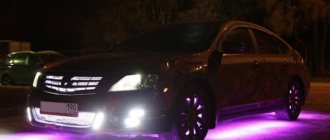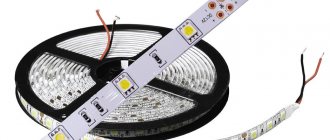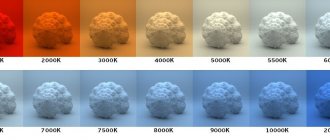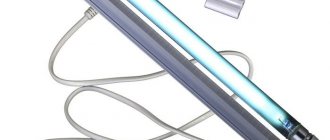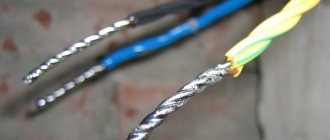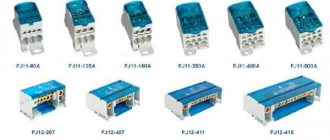What is SMD and 5050 numbers? SMD stands for Surface Mounted Device in English, i.e. surface mount device. Due to the fact that the LED is sealed on top of the substrate.
Well, the numbers indicate the length and width of the LED itself. 5mm - width and 5mm - length.
LED SMD-5050 three-crystal. That is, it contains three light sources, three crystals.
Due to the larger size and die count, the 5050 should theoretically be 3 times brighter than the SMD 3528. In practice, this is not always the case.
Features and scope
The uniqueness of this type of LED strip lies in the special production technology of SMD 5050. Today, SMD 5050 remains the only widely used compact LED for SMD mounting, in the housing of which there are 3 separately controllable light-emitting crystals, which allows you to obtain almost any color of light, as well as control it light using a special controller.
Most often, SMD 5050 LED strip is used as decorative lighting:
- to fill the room with rich blue, green or red light, as well as their shades;
- to create light and music effects;
- for advertising purposes and show business;
- as a New Year's decoration.
If you need to get bright white light, then it is better to glue a strip of powerful SMD 5730 LEDs in parallel with it.
Advantages of modern LED technology
LED strips wouldn't be so popular if they didn't have several amazing benefits.
- They are installed without any difficulties. Many products have adhesive tape on the back that adheres to almost any surface.
- Compared, for example, with an incandescent lamp, this lighting equipment usually lasts longer.
- Thanks to their design, they cannot overheat.
- They can be cut. This makes it possible to create luminous forms of amazing geometry. This feature determines the variety of modern illuminated advertising and provides ample opportunities for illuminating buildings for various purposes.
- This is a fairly economical type of lighting.
In general, the range of prices for the lighting equipment in question is quite large. For example, there are very cheap Chinese-made products that don’t even have the manufacturer’s name written on them. They have weak capabilities and break down quickly. “Branded” LEDs have a higher cost, but their reliability is obvious.
Execution options
LED strips assembled on SMD 5050 chips can be divided into 3 types: single-color, multi-color and addressable.
Single-color (monochrome) SMD 5050 tapes are assembled on the basis of three crystals emitting light of the same color. If you look closely at such a tape, you can see that at the cut points there are only 2 contacts for connecting “+” and “–”.
Multicolor or RGB tapes consist of chips with three crystals of different colors (Red, Green, Blue) and have 4 contact pads at the cut points. This allows the user to set any shade of light using an RGB controller.
The disadvantage of RGB strips is the low emission power when operating in white light mode. We managed to get rid of it by installing a white LED (RGBW strip) next to each RGB LED. Moreover, the white LEDs are controlled via a separate line. You can also find an option on sale where in the SMD 5050 case, in addition to RGB crystals, a white LED chip with separate control is mounted.
You can purchase RGB LED strip based on LED SMD 5050 in many online stores. The most worthy option is the online store www.giant4.ru, which has established itself as a seller of quality goods with a low price tag.
In the addressable LED strip under the SMD 5050 housing, an additional WS2812B PWM driver chip is installed with three emitting crystals. As a result, each addressable LED operates on an individual command, which it receives from a DMX controller or Arduino. Such an original solution greatly expands the capabilities of RGB LEDs, but requires the use of specialized equipment and software.
What does color temperature affect?
Color temperature determines what shade of white we will see when the diodes glow. It is measured in Kelvin (K). There are three color groups: warm (below 3500K), neutral or daytime (3500-5300K) and cold (above 5300K). When choosing a glow color, we rely on the glow temperature declared by the manufacturer.
| Declared value, K | Real value, K | |
| Sample No. 1 | 5800 — 6500 | 6177 |
| Sample No. 2 | 6000-6500 | 6856 |
| Sample No. 3 | 6500 | 6898 |
| Sample No. 4 | NO (White) | 6869 |
All four tapes have a cold glow, but again only sample 1 falls into the designated range. For the rest, we see underestimated declared indicators, i.e. in fact the tapes are colder. We assume that this was done on purpose: the colder the light of the tape, the higher its brightness appears.
Main technical characteristics
To understand whether this type of LED strip is suitable for solving the tasks, you need to know its parameters. To do this, we suggest considering the main technical characteristics of the SMD 5050 LED strip.
Supply voltage
A significant part of LED strips are designed to operate from a 12 V DC network, which is due to several factors:
- +12 V is the standard used for many types of batteries, including automobile ones;
- +12 V allows you to power a group of 3 LEDs connected in series of any color with minimal losses on the limiting resistor;
- +12 V is the safest voltage for humans.
LED strip SMD 5050 for 12 V is the best option for designing lighting at home, because To connect it, you can use not only a ready-made power supply, but also a power supply from a computer or a battery from a UPS.
Also on sale you can find LED strips SMD 5050 for 24 V and 36 V, connected to the appropriate DC power supply, and powered from a 220 V AC network, connected via a diode rectifier. Models with such voltage are not very popular for various reasons, incl. due to the large cutting ratio. For SMD 5050 address tape, the supply voltage is 5 V.
Degree of protection against moisture and dust
An important parameter when choosing an LED strip is the degree of protection from external influences of solid objects and water (IPXX). This parameter cannot be neglected, because it affects the cost and ability of the product to withstand the negative influence of external factors during operation. As a rule, the outer shell of SMD 5050 LED strips has the following protection class:
- IP20 – from solid objects with a diameter of more than 12.5 mm and does not prevent the ingress of water. This product does not have any coating and can only be used inside dry rooms (living rooms, bedrooms, offices).
- IP33 – from solid objects with a diameter of more than 2.5 mm and from drops of water. In this case, the coating is made of a thin layer of varnish. In addition to dry rooms, the tape can be used to illuminate the kitchen, where there is a possibility of water droplets getting into it.
- IP54 – with partial protection from dust and splashing water in the form of a silicone layer only on the elements side. As in the previous version, this tape is intended for interior decoration of kitchens and other rooms with temporarily high humidity.
- IP65 – with full protection against dust and jets of water. In this case, the protective layer is a silicone coating on all sides. LED strip with IP above 65 is quite suitable for street lighting and bathrooms.
- IP67 – withstands short-term exposure to water. Visually, it differs from products with IP65 in the type of shell (PVC profile and silicone on top). It is perfect for car and bicycle tuning.
- IP68 – the highest degree of dust and moisture protection. This LED strip is placed inside a PVC tube and can withstand the effects of water under pressure for a long time without damage. Its scope of application is the decoration of pools and fountains.
LED Density
This parameter indicates the number of LEDs in one linear meter of strip and can take the following values: 30, 60, 120 and 240 pcs/m. The higher the installation density, the greater the luminous flux and power consumption of the SMD 5050 LED strip. To prevent degradation of the LEDs, the strip with a density of 120 and 240 LEDs per meter must be glued to an aluminum profile.
Sometimes instead of density (pcs/m.) on the reel you can see the inscription “quantity - 300 pcs.” This means that the manufacturer indicated the total number of LEDs in a strip 5 meters long. Accordingly, the density of such tape is standard – 60 pcs/m.
Light flow
For monochrome and RGB LED strips SMD 5050, the resulting luminous flux depends on the color of the glow. It is known that the human eye perceives green light best. Therefore, an RGB strip turned on in green light mode appears the brightest. Also, do not forget that the luminous flux of the Economy class LED strip is approximately 30% lower than that of the Premium class. Moreover, a significant difference in quality can be observed even among one manufacturer. For example:
- Foton SMD5050-30led/m-RGB-IP20-Econom – 180 lm;
- Foton SMD5050-30led/m-RGB-IP20-Premium – 270 lm.
The luminous flux of the SMD5050 white LED strip is affected by color temperature (hue). For an SMD 5050 chip with neutral light (4500-5500°K), the luminous flux of 18 lm is considered the norm; warm light (3000-4000°K) – 16 lm; cold light (6000-7500°K) – 20 lm. Multiplying these values by the density, we get the total number of lumens emitted by one meter of LED strip.
SMD 5050-72
Not all manufacturers produce this tape. This is explained by the fact that most often it is present in the premium and elite class.
And as mentioned above, each of its LEDs is a separate working module.
That is, you can literally cut it diode-wise.
This is very convenient because you will no longer be tied to a certain multiple of 5 or 10 cm. You can cut it where necessary, without any reserves or extra centimeters.
But they are the ones who often interfere and spoil the entire lighting pattern, if you didn’t guess correctly with the overall footage.
It also makes it easy to compose individual inscriptions or letters. Some people use 5050/72 to frame car rear lights.
The power of the SMD strip with 72 diodes is 17.2 W/m. It heats up even more than the previous one, so the aluminum profile is 100% needed here.
Its luminous flux is 1440 lumens. The light strip is even denser than that of the 60-diode type.
Power calculation for choosing a power supply
The key to reliable operation of any LED strip is a properly selected power supply. You should choose a power supply for a single-color LED strip on SMD 5050 based on two parameters: output voltage and the power that it is capable of delivering to the load. The output voltage of the power supply must match the supply voltage of the LED strip. In most cases it is 12 V, less often 24 V. The power is calculated based on the length of the tape and its density. To facilitate calculations, there is a special table that shows the power consumption of 1 meter, taking into account the type of LEDs and installation density. Regarding the SMD 5050 tape, we have the following data:
- 30 led/m – 7.2 W;
- 60 led/m – 14.4 W;
- 120 led/m – 28.8 W;
- 240 led/m – 57.6 W.
Here the power values are indicated for maximum brightness mode. This means that the RGB strip, operating in single color mode, will consume 3 times less energy, because Only 1 of 3 crystals will be used.
The power of the power supply is determined by the formula:
- P1m – power consumption of one meter, W;
- N – total length of all segments connected to the power supply, m;
- K – power reserve factor. Usually K=1.2.
To connect an RGB LED strip to an SMD 5050, in addition to the power supply, you will need an RGB controller. How to choose the right RGB controller, in what cases is a signal amplifier needed, and which connection diagram is better? Answers to these questions can be found in the article “Connecting RGB strips of different lengths.”
Classification by degrees of protection
Thanks to the special coating, reliable protection of the tape is formed from various types of exposure. The parameter is displayed as an index:
- 1 – indicates a high degree of protection against the ingress of solids or foreign objects;
- 2 – indicates the parameters of protecting the product from moisture penetration.
All digital index values are indicated in specialized documents according to state standards.
Reliable manufacturers
In addition to technical characteristics, one should not forget about quality. Especially if you are faced with the task of assembling suspended ceiling lighting. It is best to buy LED strip from brands such as Philips, Feron, Gauss. However, due to the high cost, their products are in little demand. In this regard, potential buyers are forced to choose from what the Russian market offers. Here you can trust SMD 5050 LED strips in the mid-price range from Navigator, JazzWay, Foton, Lumex, Giant4, Horoz Electric, Arlight.
A few words about products from AliExpress
Trying to save money, many potential buyers turn to AliExpress to search for cheap products. At the same time, they forget that this trading platform is a leader in the sale of low-quality products. And even numerous positive reviews do not guarantee the quality of the product and the integrity of the seller. Practice shows that due to gross violation of technology and the use of low-quality components, LED strips from China partially or completely fail in the first year of operation. Therefore, cheap LED strips from AliExpress are suitable only for making New Year’s decorations and other homemade items.
Color rendering index, CRI
Color rendering index (CRI) is a coefficient that reflects the ability of a light source to correctly display the colors of the objects it illuminates. Good lighting does not distort shades and does not create additional strain on vision. The ideal indicator is considered to be “100”, but in practice it is unattainable. The further from 100, the worse. A good result for LED strips is 90-95.
| Stated value, CRI | Real value, CRI | |
| Sample No. 1 | 85 | 88.4 |
| Sample No. 2 | 70 | 70.8 |
| Sample No. 3 | NO | 64.5 |
| Sample No. 4 | NO | 65 |
The last 2 films had a very poor CRI. They will greatly distort the color of objects. As a result, they will spoil the interior or distort the shades of the illuminated image. Only samples 1 and 2 showed an acceptable result, which will correctly convey the color of the object and will not create additional strain on the eyes.

